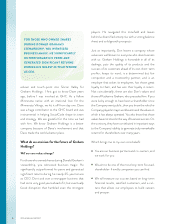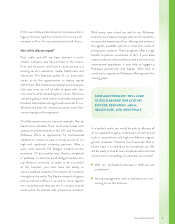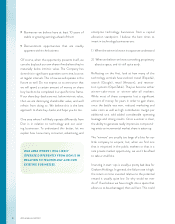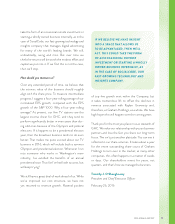Washington Post 2015 Annual Report Download - page 18
Download and view the complete annual report
Please find page 18 of the 2015 Washington Post annual report below. You can navigate through the pages in the report by either clicking on the pages listed below, or by using the keyword search tool below to find specific information within the annual report.
Kaplan University’s higher education enrollments by certificate and degree programs are set forth below:
At December 31
2015 2014 2013
Certificate ............................................ 4.4% 2.3% 1.5%
Associate’s ........................................... 25.0% 29.6% 32.1%
Bachelor’s............................................ 48.4% 44.3% 43.5%
Master’s ............................................. 22.2% 23.8% 22.9%
Total ............................................ 100.0% 100.0% 100.0%
Financial Aid Programs and Regulatory Environment
Funds provided under the U.S. Federal student financial aid programs that have been created under Title IV of
the U.S. Federal Higher Education Act of 1965, as amended (Higher Education Act), historically have been
responsible for a majority of KHE revenues. During 2015, funds received under Title IV programs accounted for
approximately $628 million, or approximately 74%, of total KHE revenues, and 32.6% of Kaplan, Inc. revenues.
The Company estimates that funds received from students borrowing under third-party private loan programs
comprised approximately 0.3% of KHE revenues. Direct student payments, funds received under various state
and federal agency grant programs and corporate reimbursement under tuition assistance programs accounted for
most of the remaining 2015 KHE revenues. The significant role of Title IV funding in the operations of KHE is
expected to continue.
Title IV programs encompass various forms of student loans and non-repayable grants. In some cases, the U.S.
Federal government subsidizes a portion of the student interest expense of Title IV loans. Subsidized loans and
grants are only available to students who can demonstrate financial need. During 2015, about 81.5% of the
approximate $628 million of Title IV funds received by KHE came from student loans, and approximately 18.5%
of such funds came from grants.
Title IV Eligibility and Compliance With Title IV Program Requirements. To maintain eligibility to
participate in Title IV programs, a school must comply with extensive statutory and regulatory requirements
relating to its financial aid management, educational programs, financial strength, administrative capability,
compensation practices, facilities, recruiting practices, representations made to current and prospective students,
and various other matters. In addition, the school must be licensed, or otherwise legally authorized, to offer
postsecondary educational programs by the appropriate governmental body in the state or states in which it is
physically located or is otherwise subject to state authorization requirements, be accredited by an accrediting
agency recognized by the U.S. Department of Education (ED) and be certified to participate in the Title IV
programs by the ED. Schools are required periodically to apply for renewal of their authorization, accreditation
or certification with the applicable state governmental bodies, accrediting agencies and the ED. In accordance
with ED regulations, our campuses are grouped into institutions consisting of a main campus and, if applicable,
additional campus locations. In turn, each overall institution is assigned its own identification number, known as
an OPEID number for the purpose of determining compliance with certain Title IV requirements. As a result, as
of the end of 2015, the schools in KHE consist of a total of three institutions or OPEID numbers. No assurance
can be given that our institutions or their individual programs will maintain their Title IV eligibility, accreditation
and state authorization in the future or that the ED might not successfully assert that one or more of the
institutions has previously failed to comply with Title IV requirements.
The ED may place a school on provisional certification status under certain circumstances, including, but not
limited to, failure to satisfy certain standards of financial responsibility or administrative capability, or upon a
change in ownership resulting in a change of control. Provisional certification status carries fewer due process
protections than full certification. As a result, the ED may withdraw an institution’s provisional certification
more easily than if it is fully certified. In addition, the ED may subject an institution on provisional certification
status to greater scrutiny in some instances, for example, when it applies for approval to add a new location or
3 GRAHAM HOLDINGS COMPANY
























